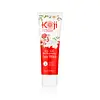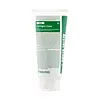What's inside
What's inside
 Key Ingredients
Key Ingredients

 Benefits
Benefits

 Concerns
Concerns

 Ingredients Side-by-side
Ingredients Side-by-side

Water
Skin ConditioningGlycerin
HumectantStearic Acid
CleansingLauric Acid
CleansingMyristic Acid
CleansingPotassium Hydroxide
BufferingPropylene Glycol
HumectantGlycol Distearate
EmollientDecyl Glucoside
CleansingCocamidopropyl Betaine
CleansingGlyceryl Stearate
EmollientSodium Methyl Cocoyl Taurate
CleansingAcrylates/C10-30 Alkyl Acrylate Crosspolymer
Emulsion StabilisingPhenoxyethanol
PreservativePEG-100 Stearate
Parfum
MaskingDisodium EDTA
3-O-Ethyl Ascorbic Acid
Skin ConditioningTocopheryl Acetate
AntioxidantInositol
HumectantPanthenol
Skin ConditioningGuar Hydroxypropyltrimonium Chloride
Skin ConditioningButylene Glycol
HumectantKojic Acid
AntioxidantSodium Hyaluronate
HumectantHibiscus Sabdariffa Flower Extract
Skin Conditioning1,2-Hexanediol
Skin ConditioningSpiraea Ulmaria Flower Extract
Skin ConditioningBellis Perennis Flower Extract
Skin ConditioningJasminum Officinale Flower Extract
MaskingWater, Glycerin, Stearic Acid, Lauric Acid, Myristic Acid, Potassium Hydroxide, Propylene Glycol, Glycol Distearate, Decyl Glucoside, Cocamidopropyl Betaine, Glyceryl Stearate, Sodium Methyl Cocoyl Taurate, Acrylates/C10-30 Alkyl Acrylate Crosspolymer, Phenoxyethanol, PEG-100 Stearate, Parfum, Disodium EDTA, 3-O-Ethyl Ascorbic Acid, Tocopheryl Acetate, Inositol, Panthenol, Guar Hydroxypropyltrimonium Chloride, Butylene Glycol, Kojic Acid, Sodium Hyaluronate, Hibiscus Sabdariffa Flower Extract, 1,2-Hexanediol, Spiraea Ulmaria Flower Extract, Bellis Perennis Flower Extract, Jasminum Officinale Flower Extract
Water
Skin ConditioningMyristic Acid
CleansingGlycerin
HumectantStearic Acid
CleansingPotassium Hydroxide
BufferingPropylene Glycol
HumectantLauric Acid
CleansingGlycol Distearate
EmollientGlyceryl Stearate Se
EmulsifyingCoco-Glucoside
CleansingButylene Glycol
HumectantCetearyl Alcohol
EmollientCentella Asiatica Extract
CleansingCollagen
MoisturisingSoluble Collagen
HumectantCollagen Amino Acids
MoisturisingHydrolyzed Collagen
EmollientCollagen Extract
Skin ConditioningOriganum Vulgare Leaf Extract
Skin ConditioningChamaecyparis Obtusa Leaf Extract
Skin ConditioningSalix Alba Bark Extract
AstringentLactobacillus/Soybean Ferment Extract
Skin ConditioningPortulaca Oleracea Extract
Skin ConditioningCinnamomum Cassia Bark Extract
MaskingScutellaria Baicalensis Root Extract
AstringentPanicum Miliaceum Seed Extract
Skin ConditioningLavandula Angustifolia Oil
MaskingCitrus Aurantium Bergamia Fruit Oil
MaskingPelargonium Graveolens Flower Oil
MaskingSalvia Sclarea Oil
MaskingCitrus Limon Peel Oil
MaskingJuniperus Virginiana Oil
MaskingPanthenol
Skin ConditioningSodium Hyaluronate
HumectantBiosaccharide Gum-4
Skin ConditioningAsiatic Acid
Skin ConditioningAsiaticoside
AntioxidantMadecassic Acid
Skin ConditioningMadecassoside
AntioxidantGlycine
BufferingSerine
MaskingGlutamic Acid
HumectantAspartic Acid
MaskingLeucine
Skin ConditioningAlanine
MaskingLysine
Skin ConditioningArginine
MaskingTyrosine
MaskingPhenylalanine
MaskingValine
MaskingThreonine
Proline
Skin ConditioningIsoleucine
Skin ConditioningHistidine
HumectantMethionine
Skin ConditioningCysteine
AntioxidantTannic Acid
AstringentCitric Acid
BufferingCaprylic/Capric Triglyceride
MaskingHydrogenated Phosphatidylcholine
EmulsifyingSucrose Stearate
EmollientDisodium EDTA
Lactose
HumectantCellulose
AbsorbentAscorbyl Palmitate
AntioxidantTocopheryl Acetate
AntioxidantHydroxypropyl Methylcellulose
Emulsion StabilisingJojoba Esters
Emollient1,2-Hexanediol
Skin ConditioningPotassium Sorbate
PreservativeCI 77289
Cosmetic ColorantLinalool
PerfumingLimonene
PerfumingCitronellol
PerfumingGeraniol
PerfumingWater, Myristic Acid, Glycerin, Stearic Acid, Potassium Hydroxide, Propylene Glycol, Lauric Acid, Glycol Distearate, Glyceryl Stearate Se, Coco-Glucoside, Butylene Glycol, Cetearyl Alcohol, Centella Asiatica Extract, Collagen, Soluble Collagen, Collagen Amino Acids, Hydrolyzed Collagen, Collagen Extract, Origanum Vulgare Leaf Extract, Chamaecyparis Obtusa Leaf Extract, Salix Alba Bark Extract, Lactobacillus/Soybean Ferment Extract, Portulaca Oleracea Extract, Cinnamomum Cassia Bark Extract, Scutellaria Baicalensis Root Extract, Panicum Miliaceum Seed Extract, Lavandula Angustifolia Oil, Citrus Aurantium Bergamia Fruit Oil, Pelargonium Graveolens Flower Oil, Salvia Sclarea Oil, Citrus Limon Peel Oil, Juniperus Virginiana Oil, Panthenol, Sodium Hyaluronate, Biosaccharide Gum-4, Asiatic Acid, Asiaticoside, Madecassic Acid, Madecassoside, Glycine, Serine, Glutamic Acid, Aspartic Acid, Leucine, Alanine, Lysine, Arginine, Tyrosine, Phenylalanine, Valine, Threonine, Proline, Isoleucine, Histidine, Methionine, Cysteine, Tannic Acid, Citric Acid, Caprylic/Capric Triglyceride, Hydrogenated Phosphatidylcholine, Sucrose Stearate, Disodium EDTA, Lactose, Cellulose, Ascorbyl Palmitate, Tocopheryl Acetate, Hydroxypropyl Methylcellulose, Jojoba Esters, 1,2-Hexanediol, Potassium Sorbate, CI 77289, Linalool, Limonene, Citronellol, Geraniol
Ingredients Explained
These ingredients are found in both products.
Ingredients higher up in an ingredient list are typically present in a larger amount.
1,2-Hexanediol is a synthetic liquid and another multi-functional powerhouse.
It is a:
- Humectant, drawing moisture into the skin
- Emollient, helping to soften skin
- Solvent, dispersing and stabilizing formulas
- Preservative booster, enhancing the antimicrobial activity of other preservatives
Butylene Glycol (or BG) is used within cosmetic products for a few different reasons:
Overall, Butylene Glycol is a safe and well-rounded ingredient that works well with other ingredients.
Though this ingredient works well with most skin types, some people with sensitive skin may experience a reaction such as allergic rashes, closed comedones, or itchiness.
Learn more about Butylene GlycolDisodium EDTA plays a role in making products more stable by aiding other preservatives.
It is a chelating agent, meaning it neutralizes metal ions that may be found in a product.
Disodium EDTA is a salt of edetic acid and is found to be safe in cosmetic ingredients.
Learn more about Disodium EDTAGlycerin is already naturally found in your skin. It helps moisturize and protect your skin.
A study from 2016 found glycerin to be more effective as a humectant than AHAs and hyaluronic acid.
As a humectant, it helps the skin stay hydrated by pulling moisture to your skin. The low molecular weight of glycerin allows it to pull moisture into the deeper layers of your skin.
Hydrated skin improves your skin barrier; Your skin barrier helps protect against irritants and bacteria.
Glycerin has also been found to have antimicrobial and antiviral properties. Due to these properties, glycerin is often used in wound and burn treatments.
In cosmetics, glycerin is usually derived from plants such as soybean or palm. However, it can also be sourced from animals, such as tallow or animal fat.
This ingredient is organic, colorless, odorless, and non-toxic.
Glycerin is the name for this ingredient in American English. British English uses Glycerol/Glycerine.
Learn more about GlycerinGlycol Distearate serves as a pearlizing or opacifying agent in cosmetic products.
It's often included in cleansers and haircare products to give them a lustrous or shimmering appearance.
It is derived from stearic acid, a natural fatty acid commonly found in vegetable oils and animal fats.
Glycol Distearate isn't fungal acne safe.
Learn more about Glycol DistearateLauric Acid is a fatty acid or lipid. About half of fatty acids in coconut oil is lauric acid.
This ingredient helps hydrate and sooth skin. As a humectant, it helps trap moisture. It also aids in cleaning and enhancing the texture of products.
Lauric acid may not be Malassezia folliculitis, or fungal acne, safe.
Learn more about Lauric AcidMyristic Acid is a saturated fatty acid. It is naturally found in milk fat. Other sources include palm oil, coconut oil, and butter fat.
Myristic Acid is an emulsifer and cleanser. As an emulsifer, it stabilizes a product by preventing ingredients from separating. Myristic Acid helps clean your skin by acting as a surfactant. It tends to gather oil and dirt on your skin to be easily rinsed away.
One study from 2021 found Myristic Acid to have anti-inflammatory properties.
Learn more about Myristic AcidPanthenol is a common ingredient that helps hydrate and soothe the skin. It is found naturally in our skin and hair.
There are two forms of panthenol: D and L.
D-panthenol is also known as dexpanthenol. Most cosmetics use dexpanthenol or a mixture of D and L-panthenol.
Panthenol is famous due to its ability to go deeper into the skin's layers. Using this ingredient has numerous pros (and no cons):
Like hyaluronic acid, panthenol is a humectant. Humectants are able to bind and hold large amounts of water to keep skin hydrated.
This ingredient works well for wound healing. It works by increasing tissue in the wound and helps close open wounds.
Once oxidized, panthenol converts to pantothenic acid. Panthothenic acid is found in all living cells.
This ingredient is also referred to as pro-vitamin B5.
Learn more about PanthenolPotassium hydroxide is commonly known as caustic potash. It is used to fix the pH of a product or as a cleaning agent in soap. In cleansers, it is used for the saponification of oils.
Sapnification is the process of creating fatty acid metal salts from triglycerides and a strong base. During this process, Potassium Hydroxide is used up and is not present in the final product.
Using high concentrations of Potassium Hydroxide have shown to irritate the skin.
Learn more about Potassium HydroxidePropylene Glycol is an odorless, colorless liquid. As a humectant, it helps skin retain moisture. It also aids in delivering active ingredients.
Another role of this ingredient is preventing a product from melting or freezing. Propylene glycol also adds antimicrobrial properties to a product, elongating product lifespan.
This ingredient is considered an organic alcohol and commonly added into both cosmetics and foods.
Those with sensitive skin or conditions may develop a rash when using this ingredient.
Learn more about Propylene GlycolSodium Hyaluronate is hyaluronic acid's salt form. It is commonly derived from the sodium salt of hyaluronic acid.
Like hyaluronic acid, it is great at holding water and acts as a humectant. This makes it a great skin hydrating ingredient.
Sodium Hyaluronate is naturally occurring in our bodies and is mostly found in eye fluid and joints.
These are some other common types of Hyaluronic Acid:
Learn more about Sodium HyaluronateStearic Acid is a fatty acid. It is an emollient, emulsifier, and texture enhancer.
As an emollient, stearic acid helps soften skin. It aids the skin's protective barrier by preventing water loss. It also provides a gentle cleansing effect without stripping away natural oils.
Stearic acid may also be used to enhance the texture of products. It can add volume and stabilize ingredients such as water and oil. This can help water and oil ingredients from separating.
Sources of stearic acid include animal or vegetable fats/oils such as coconut or shea. It can be naturally found in butter, cocoa butter, shea butter, vegetable fats, and animal tallow.
This ingredient may not be Malassezia folliculitis, or fungal-acne safe.
Learn more about Stearic AcidTocopheryl Acetate is AKA Vitamin E. It is an antioxidant and protects your skin from free radicals. Free radicals damage the skin by breaking down collagen.
One study found using Tocopheryl Acetate with Vitamin C decreased the number of sunburned cells.
Tocopheryl Acetate is commonly found in both skincare and dietary supplements.
Learn more about Tocopheryl AcetateWater. It's the most common cosmetic ingredient of all. You'll usually see it at the top of ingredient lists, meaning that it makes up the largest part of the product.
So why is it so popular? Water most often acts as a solvent - this means that it helps dissolve other ingredients into the formulation.
You'll also recognize water as that liquid we all need to stay alive. If you see this, drink a glass of water. Stay hydrated!
Learn more about Water